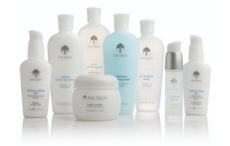Skin Aging – Do Seasonal Changes Affect It?
March 09, 2015

As both consumers and scientists have come to appreciate, skin aging is an amazingly complicated and unavoidable phenomenon. As we get older, our skin ages along with the rest of our body, but it also ages as a result of being the main organ exposed to the outside environment.

A few external factors that are thought to contribute to skin aging are:
- UV/sun exposure
- pollution
- smoking
- illness
- gravity
- diet1
Sun exposure is believed to accelerate the appearance of aging2, but what about weather and seasonal changes? Do they have any effect on the visible signs of aging?
This is not an easy question to answer. Aging is a very slow, multifactorial process, while seasonal changes are constantly recurring. Furthermore, scientific studies of the skin are rarely designed to last more than a year, making it difficult to truly study and understand.
However, here is a snapshot of what has been learned about seasonal effects on skin so far:

1. Visible signs of skin aging include skin texture (lines, wrinkles and roughness), changes in pigmentation, and sagging. A year-long study of 32 Japanese men and women revealed that while there was no seasonal effect on wrinkle intensity, there was an observable increase in eye wrinkle depth for men but not women. Another study examined skin roughness and normal skin characteristics as a function of seasonality and age. They determined that ingestion of a micronutrient supplement was able to prevent the increased skin roughness and decreased skin thickness over the four-month winter period in women aged 35-554.
2. Skin hydration is a parameter that has been observed and quantified to vary with both age and seasonality.
3. A study found that water content of the upper stratum corneum of the forearm was lower in subjects age 59+ than in those ages 22-405. In contrast, there was no significant difference for cheek skin among the same two groups. Increased skin hydrationwas observed in summer on both forearm and cheek of young and old subjects. They further quantified the amounts of various water-holding substances such as Natural Moisturizing Factors (NMFs), urea, trans-urocanic acid (t-UCA) and lactate in the skin and lipids. They found differences in the concentration of some of these substances with seasonality and age, but there was also some variation depending on body site.
4. With increasing age and sun exposure, the skin experiences changes in pigmentation level and evenness. Certainly, pigmentation increases during summer months on sun-exposed areas, but the level of increase is dependent on sunscreen use, ethnicity, age, gender and geographic location6. A study of 602 Japanese women ages 5 - 65, approximately half living in northern and the other half living in southern Japan, found noticeable effects on skin appearance of exposed areas in the two groups7. On average, women living in southern Japan where sun/UV exposure is about1.5 times that in the north, experience a quicker onset of facial wrinkling of about 8 years, and of about 16 years in hyperpigmentation vs. their northern counterparts.
From this, it appears there are initial indications that seasonal variation also affects some aging-linked skin changes. However, more in-depth studies are still required to fully answer the question. This is because both the aging process and humans are extremely complicated, and there is still much for researchers to uncover. It also may indicate that there is no single skincare solution to address seasonal effects for everyone. Thus, individuals should pay attention to how their skin needs may change from season to season and adjust their skincare regimen accordingly.■
NU SKIN RECOMMENDS:

Perennial - Protect skin, provide resiliency, and increase skin's moisture retention during winter months with this fragrance-free formula.

Sole Solution - Therapeutic foot cream for active feet suffering from rough, dry, or cracked skin.
1. Vierkötter, A. & Krutmann, J. (2012) Environmental influences on skin aging and ethnic-specific manifestations. Dermato-Endocrinology 4:227-231.
2. Wulf, H.C. et al. (2004) Skin aging and natural photoprotection. Micron 35:185-191.
3. Tsukahara, K. et al. (2013) Seasonal and annual variation in the intensity of facial wrinkles. Skin Res Technol 19:279-287.
4. Fanian, F. et al. (2013) Efficacy of micronutrient supplementation on skin aging and seasonal variation: a randomized, placebo-controlled, double-blind study. Clin Interventions Aging 2013:1527-1537.
5. Egawa, M. & Tagami, H. (2008) Comparison of the depth profiles of water and water-binding substances in the stratum corneum determined in vivo by Raman spectroscopy between the cheek and volar forearm skin: effects of age, seasonal changes and artificial forced hydration. Brit J Dermatol 158:251-260.
6. Roh, K.Y- et al. (2001) Pigmentation in Koreans: study of the differences from Caucasians in age, gender and seasonal variations. Brit J Dermatol 144:94-99.
7. Hillebrand, G.G. et al. (2001) Quantitative evaluation of skin condition in an epidemiological survey of females living in northern versus southern Japan. J Derm Sci 27 Suppl 1:S42-S52.
You Might Also Like:
-
Have you ever wondered if where you live and work has an impact on how your skin looks and ages over time? Certainly, we are all aware that the amount and intensity of sun exposure does contribute to aging. The use of products with a good sunscreen can really help to provide protection against the aging effects of UV exposure. However, research is now revealing there is more to this story and w...
-
We live in a world of customization. Almost every element of your life can be tailored to your unique needs and specifications. From diet and exercise to entertainment and media consumption, the power to customize your experiences lies within your grasp. The ability to control your skin care regimen puts you in the driver’s seat, ensuring that you’ll be treating your skin in the best way possible ...

